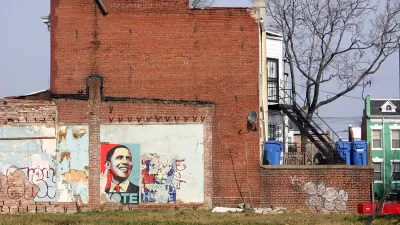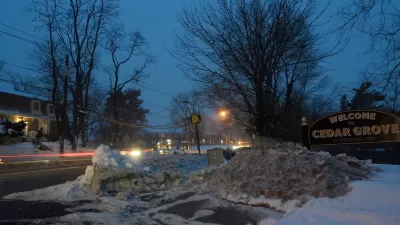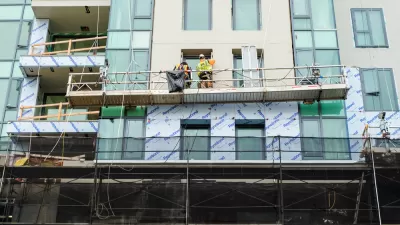As public art proliferates as a strategy to engage disaffected youth and enliven neighborhoods, Philip Langdon argues that an additional standard must be considered when evaluating such projects -- their content.
Langdon's commentary was spurred by recent discussions held at an urban journalists' forum organized by the Lincoln Institute of Land Policy, and more specifically by images of public murals shown by Roger Cummings, co-founder and artistic director of Juxtaposition Arts, an arts-oriented community development corporation in Minneapolis. Some of the murals shown in Cummings' presentation depicted images Langdon considered disturbing: "a huge painting of a man pointing what appeared to be a weapon toward a plaza; representations of guns and skulls; symbols of death."
These images, and responses from forum attendees such as Alex Marshall, who writes for the Regional Plan Association in New York, has Langdon arguing that "The fundamental problem is that public art does not always make a place better."
"Marshall suggested that an in-your-face kind of art may degrade public space. In a city, things that are painted on surfaces visible to everyone greatly affect people's thoughts, moods, outlooks. He likened an aggressive mural on the exterior of a conspicuous building to letting someone paint a disturbing scene on your living room wall."
Langdon continues, "In these financially pressed days, when those who want to improve a city often have to do so with limited resources, there's a danger of driving a needed restraint or subtlety out of our shared living rooms. A respect for the sensibilities of others is one of the things that makes living in dense agglomerations palatable; there's a problem when public art forgets that."
Join in the already spirited debate about Langdon's argument in the comments section of the article.
FULL STORY: When public art disturbs its viewers

Maui's Vacation Rental Debate Turns Ugly
Verbal attacks, misinformation campaigns and fistfights plague a high-stakes debate to convert thousands of vacation rentals into long-term housing.

Planetizen Federal Action Tracker
A weekly monitor of how Trump’s orders and actions are impacting planners and planning in America.

In Urban Planning, AI Prompting Could be the New Design Thinking
Creativity has long been key to great urban design. What if we see AI as our new creative partner?

King County Supportive Housing Program Offers Hope for Unhoused Residents
The county is taking a ‘Housing First’ approach that prioritizes getting people into housing, then offering wraparound supportive services.

Researchers Use AI to Get Clearer Picture of US Housing
Analysts are using artificial intelligence to supercharge their research by allowing them to comb through data faster. Though these AI tools can be error prone, they save time and housing researchers are optimistic about the future.

Making Shared Micromobility More Inclusive
Cities and shared mobility system operators can do more to include people with disabilities in planning and operations, per a new report.
Urban Design for Planners 1: Software Tools
This six-course series explores essential urban design concepts using open source software and equips planners with the tools they need to participate fully in the urban design process.
Planning for Universal Design
Learn the tools for implementing Universal Design in planning regulations.
planning NEXT
Appalachian Highlands Housing Partners
Mpact (founded as Rail~Volution)
City of Camden Redevelopment Agency
City of Astoria
City of Portland
City of Laramie





























